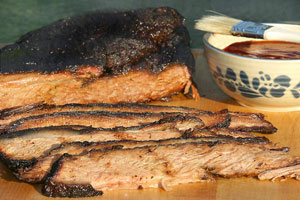Q: I love barbecue and often cook pork shoulder but some of my friends say true barbecue is beef brisket. How do I smoke brisket? —John
A: Hi John…
Thanks for writing. Despite what others may say, the key to great smoked brisket is cooking. Sure, the preparation plays a large part in making a good brisket but does it really make a difference if you’re smoking CAB (Certified Angus Beef), Prime-grade brisket or run-of-the-mill Choice brisket? The difference between a good brisket and a great brisket is in the cooking, not the grade of the meat.
There are scores of “how-to” articles and recipes on preparing barbecue brisket. Each cook has his or her own way… their own rub, mop and sauce. This is my way of cooking brisket and teaching others how to do it… feel free to modify the recipes, make them your own. Experiment… follow the general guidelines and then branch out and create your way of smoking brisket.
Brisket is cut from the underside chest area of a cow or steer and is layered with fat and collagen. The muscle gets a lot of exercise, so it’s a very tough piece of meat that benefits from long cooking. As collagen cooks it turns into a gelatin and dissolves into the meat. The collagen and the fat also help to keep the brisket from drying out and becoming tough during the long cooking process.
Patience is the secret to a perfectly smoked brisket. Plan on 1 1/2 to 2 hours per pound… that means a 10-pound brisket could take 15 to 20 hours to cook. Brisket is not a quick steak on the grill!
A good rub and the right use of wood will complement your brisket in the quest to find perfection. Rubs, like other seasonings and sauces, shouldn’t overpower the flavor of the meat.
Get a brisket with good marbling, white fat and a deep color in the meat. When smoking you will want the brisket to cook fat side up so that the melting fat will run over the brisket and keep it moist. It’s your choice whether you want to cook a whole “packer trimmed” brisket or just the brisket flat. For small gatherings, a flat is usually a good size. For this smoking, I purchased an 11-pound whole brisket and trimmed most the flat from the point (the point will be used for a future braised brisket recipe).
The brisket needs to be rinsed in cold water and patted dry with paper towels before smoking. If you are going to apply a rub it should be done at least an hour before the brisket goes on the smoker.
Wood: Since brisket is smoked for a very long time, avoid a strong or bitter smoke. (Mesquite, the traditional wood for smoking in Texas, can be very bitter if over-used.) My preference is a mixture of 50% oak wood chips, 20% hickory chips and 30% apple chips.
Rubs: Any seasonings you like will generally make a great rub for brisket. Rubs should complement the sauce, if used, and the sauce should enhance the rub flavors. To achieve this, use similar spices and herbs in the sauce that are used in the rub.
Sauces: My choice for brisket is a finishing sauce, one that is brushed on at the very end of the cooking or served at the table as a dipping sauce. Most Texas-style sauces use tomato as a base but the choice is yours.
With the brisket ready, get the smoker ready. The target temperature is 225 degrees F. Once the smoker is stabilized at that temperature, it’s ready for the brisket
Place the brisket, fat side up, in the center of the cooking grate and insert a remote reading thermometer probe in the thickest portion of the brisket. (I also use a second probe to monitor the temperature at the cooking grate.)
Some folks recommend wrapping the brisket with heavy duty aluminum foil after the first four or five hours of cooking (Chef Paul Kirk Ph.B, a multiple world barbecue champion and author of numerous barbecue books, calls this the “Texas Crutch” and doesn’t recommend it. I agree.)
Corn on the cob, baked beans, potato salad and cole slaw are all good side dishes for brisket. Serve with a jalapeño corn bread.
Smoked Brisket
1 (4 1/2-pound) brisket flat
6 cups mixed wood chips (3 cups oak, 1 cup hickory and 2 cups apple)
1/2 cup prepared yellow mustard
Brisket rub (see recipe below)
Rinse the brisket and pat dry. Score the fat pad into a diamond pattern (similar to a ham) but do not trim. Brush lightly with prepared mustard. Liberally sprinkle the rub on the fat pad and press in with your hand. Flip the brisket over and repeat. Wrap the brisket with food film and refrigerate overnight.
Soak the wood chips in warm water for at least 1 hour.
Prepare the smoker: Fill a charcoal chimney with lump charcoal and light. When the coals in the chimney are ash-covered, carefully pour the lit coals in the center of the smoker. When the temperature stabilizes at 225 degrees F. add three cups of drained wood chips to the coals.
Place the brisket, fat side up, in the center of the cooking grate. Insert a remote reading thermometer probe in the thickest part of the brisket avoiding any fat pockets.
Close the smoker and maintain the 225 degrees F. temperature for three hours, adding more pre-lit coals if necessary. After three hours, spray the brisket with your favorite mop or apple juice. Add more drained chips and preheated coals as needed and continue cooking. After another hour, spray the brisket again and continue cooking until the brisket reaches 180 degrees F. spraying with apple juice (or your favorite mop) every hour or so. (For this particular brisket, it took almost nine hours to reach the target temperature. The finished weight was 2 3/4 pounds.)
When the brisket is done, remove it from the smoker and let it rest for about 20 minutes, tented with aluminum foil, before carving. Carve the brisket across the grain into 1/4-inch slices.
Brisket Rub
2 tablespoons cracked black pepper
1 tablespoon coarse kosher salt
1 tablespoon hot Hungarian paprika
1 tablespoon chile powder
1 tablespoon brown sugar
1 teaspoon granulated garlic
1 teaspoon granulated onion
1 teaspoon dried parsley
1 teaspoon dried oregano
Combine all the ingredients in a small mixing bowl and stir well to mix.
Brisket Finishing Sauce
1 cup cider vinegar
1 cup ketchup
1/2 cup brown sugar, packed
1/4 cup Worcestershire sauce
2 tablespoons unsalted butter
2 tablespoons clover or orange blossom honey
2 teaspoons granulated garlic
1 teaspoon ground cumin seed
1 teaspoon coarse kosher salt
1/2 teaspoon granulated onion
1/4 teaspoon crushed red pepper flakes
1/4 teaspoon freshly ground black pepper
In a medium saucepan over medium heat, combine the ingredients and whisk until blended. Bring to a low boil, reduce heat, cover and simmer for 10 minutes. Serve warm or at room temperature.
ASK CHEF MIKE YOUR OWN QUESTION ABOUT GRILLING, CHILES, GADGETS, OR OTHER FOOD AND COOKING TOPICS. SEND HIM A MESSAGE HERE.
 Mike Stines is a professional chef and the Grilling and Gadgets Editor for the Burn! Blog. Mike holds a “Doctorate of Barbeque Philosophy” (Ph.B) degree from the Kansas City Barbeque society. His book—Mastering Barbecue (Ten Speed Press, 2005)—has been called the “go-to” book for BBQ knowledge.
Mike Stines is a professional chef and the Grilling and Gadgets Editor for the Burn! Blog. Mike holds a “Doctorate of Barbeque Philosophy” (Ph.B) degree from the Kansas City Barbeque society. His book—Mastering Barbecue (Ten Speed Press, 2005)—has been called the “go-to” book for BBQ knowledge.
Latest posts by Mike Stines (see all)
- Winter Shrimp Festival: Comfort of the Sea - 11/11/2022
- Singapore Fried Prawns with Dried Chile - 10/31/2022
- Planked Trout with Cayenne and Herbs - 08/02/2022







